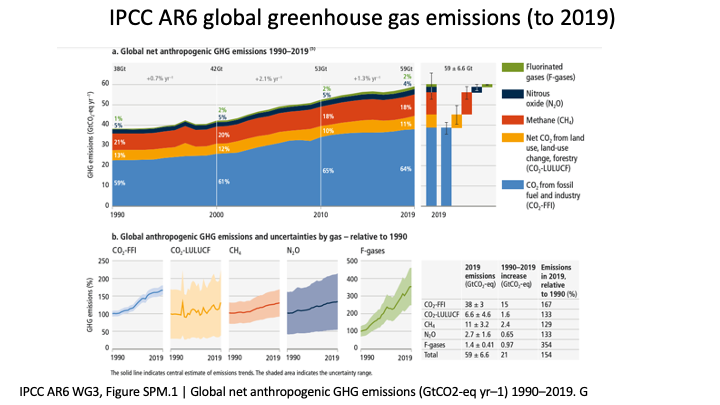Greenhouse emissions
Though the main greenhouse gases (carbon dioxide oxide, methane, nitrous, ground level ozone) cause most of the warming, black carbon (soot) is a global warming aerosol. Fossil fuels are well known as the main source of CO2 but also are a source of most greenhouse emissions.
Black carbon soot
Black carbon causing warming in two ways. Being black soot is a good heat absorber in the atmosphere and also on snow where it reduces the albedo cooling effect.
Acid aerosol cooling emissions
Also we must remember the the warming from greenhouse
emissions is off set by acid aerosol cooling emissions,
from volcanic eruptions transiently and fossil fuel air
pollution constantly.
Though the main greenhouse gases (carbon dioxide oxide, methane, nitrous, ground level ozone) cause most of the warming, black carbon (soot) is a global warming aerosol. Fossil fuels are well known as the main source of CO2 but also are a source of most greenhouse emissions.
Black carbon soot
Black carbon causing warming in two ways. Being black soot is a good heat absorber in the atmosphere and also on snow where it reduces the albedo cooling effect.
Acid aerosol cooling emissions
Also we must remember the the warming from greenhouse
emissions is off set by acid aerosol cooling emissions,
from volcanic eruptions transiently and fossil fuel air
pollution constantly.
Emissions
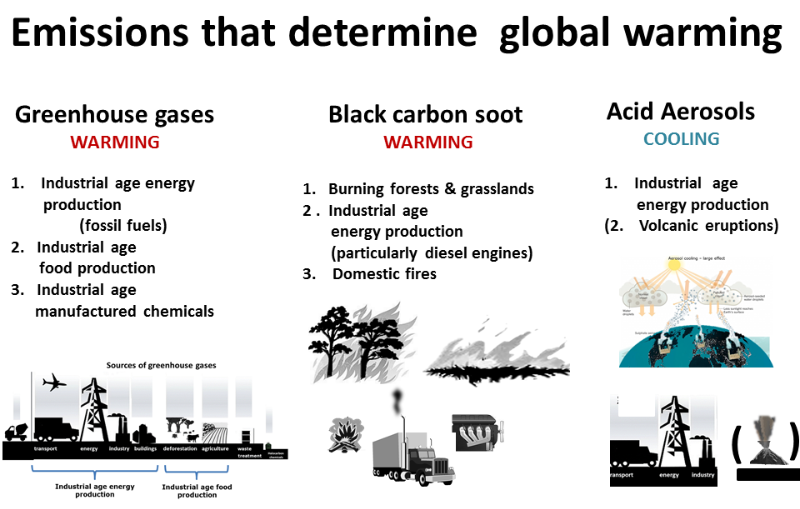
Fossil fuels
Industrial energy production is the main source of GHG emissions
Industrial energy production is the main source of GHG emissions
become over 80% of the energy comes from burning and there are
no plans to change this.
The source of energy that made for the easy labor saving affluent lives of many, is now ruining life in the future for us all through the constant
The source of energy that made for the easy labor saving affluent lives of many, is now ruining life in the future for us all through the constant
emission of very last lasting GHGs (mainly CO2) into the atmosphere.
Fossil fuel toxic emissions disable and kill a huge number of people through toxic air pollution. Most of the chronic disorders of the industrialized world have a fossil factor causing them.
FOSSIL FUEL GREENHOUSE EMISSIONS
Fossil fuels are the major source of CO2 emissions and coal has always been the worst for toxic air pollution and GHG emissions (including CO2 ocean acidification). Most countries still rely on coal and still subsidize coal.
Fossil fuel toxic emissions disable and kill a huge number of people through toxic air pollution. Most of the chronic disorders of the industrialized world have a fossil factor causing them.
FOSSIL FUEL GREENHOUSE EMISSIONS
Fossil fuels are the major source of CO2 emissions and coal has always been the worst for toxic air pollution and GHG emissions (including CO2 ocean acidification). Most countries still rely on coal and still subsidize coal.
But are also several other greenhouse emissions.
Methane and nitrous oxide (a little) is emitted by fossil fuels. Methane as fugitive emissions from natural gas (mainly methane)and from coal mining, and (research June 2014) also abandoned oil wells.
Tropospheric (ground level) ozone is a GHGs, formed by a chemical reaction between air pollutants emitted by fossil fuels catalyzed by sun warmth.
Fossil fuels are a source of BC Black Carbon (soot) mainly from diesel engines.
Ethane Propane and Butane
These GHGs are all fugative emissions from the natural gas industry, especially now fracking.
Ethane is emitted from the use of fossil fuels generally and as such has been used a fossil fuel carbon emissions marker. Ethane is also involved in the chemical reaction producing ground ozone in the air (a GHG).
Fossil fuels are the main source of air pollution cooling aerosols, but that is also a very bad thing. The fossil fuel air pollution cooling masks a lot of the CO2 warming. This deferred heat will be unmasked by counties having to clean up their air pollution and because the world has to stop burning fossil fuels - the zero carbon imperative for stabilization.
Fossil fuel pollution as well as heating the planet today, is storing up much more heat that will hit us hard in the future and last practically for ever.
Zero carbon emissions
The science is definite that to stabilize global temperature and ocean acidification we must stop all industrial carbon emissions.
Methane and nitrous oxide (a little) is emitted by fossil fuels. Methane as fugitive emissions from natural gas (mainly methane)and from coal mining, and (research June 2014) also abandoned oil wells.
Tropospheric (ground level) ozone is a GHGs, formed by a chemical reaction between air pollutants emitted by fossil fuels catalyzed by sun warmth.
Fossil fuels are a source of BC Black Carbon (soot) mainly from diesel engines.
Ethane Propane and Butane
These GHGs are all fugative emissions from the natural gas industry, especially now fracking.
Ethane is emitted from the use of fossil fuels generally and as such has been used a fossil fuel carbon emissions marker. Ethane is also involved in the chemical reaction producing ground ozone in the air (a GHG).
Fossil fuels are the main source of air pollution cooling aerosols, but that is also a very bad thing. The fossil fuel air pollution cooling masks a lot of the CO2 warming. This deferred heat will be unmasked by counties having to clean up their air pollution and because the world has to stop burning fossil fuels - the zero carbon imperative for stabilization.
Fossil fuel pollution as well as heating the planet today, is storing up much more heat that will hit us hard in the future and last practically for ever.
Zero carbon emissions
The science is definite that to stabilize global temperature and ocean acidification we must stop all industrial carbon emissions.
Instead of heading towards zero CO2 emissions, they are increasing and faster than ever.
Ever since 2008 the International Energy Agency in its annual World Energy Outlook has been warning that the world is on energy-emissions scenario that leads to a warming of at least 6°C by 2100.
That is probably the most accurate global temperature prediction from anywhere.
In July 2013 the US Energy Information Administration projected world energy consumption will increase 56% by 2040 and that the vast majority of it will still be fossil fuels.
That is clearly a planetary emergency because atmospheric greenhouse concentrations are at an extreme unprecedented (never before) high level already.
Ever since 2008 the International Energy Agency in its annual World Energy Outlook has been warning that the world is on energy-emissions scenario that leads to a warming of at least 6°C by 2100.
That is probably the most accurate global temperature prediction from anywhere.
In July 2013 the US Energy Information Administration projected world energy consumption will increase 56% by 2040 and that the vast majority of it will still be fossil fuels.
That is clearly a planetary emergency because atmospheric greenhouse concentrations are at an extreme unprecedented (never before) high level already.
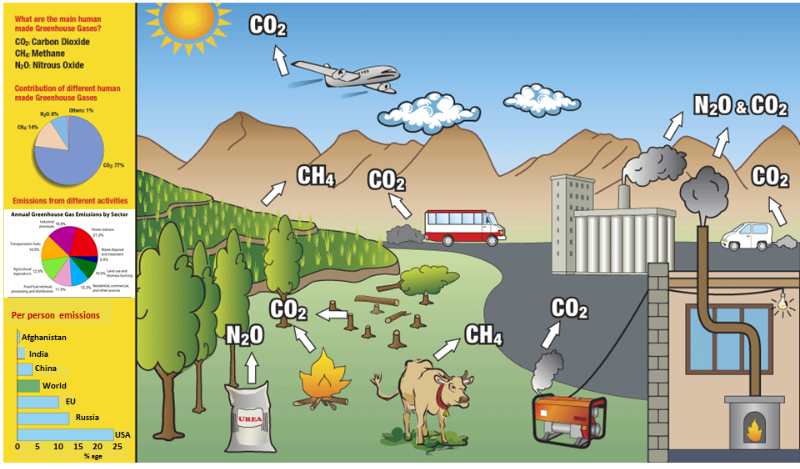
CO2 equivalent emissions
It is most important for mitigation that emissions are by CO2 equivalent rather by CO2 only
CO2 equivalent includes methane and nitrous oxide calculated as the equivalent amount of CO2
Emissions are a new record every year.
Other non CO2 greenhouse gas emissions continue to increase.
It is most important for mitigation that emissions are by CO2 equivalent rather by CO2 only
CO2 equivalent includes methane and nitrous oxide calculated as the equivalent amount of CO2
Emissions are a new record every year.
Other non CO2 greenhouse gas emissions continue to increase.
Industrial food production if fully estimated comes close to industrial energy production in emitting GHGs.
Estimated at 30% of GHG emissions
Methane: main source of emissions is livestock (ruminants exhale methane from digesting grasses)
The industrial age diet is meat heavy- bad for people and the planet.
Nitrous oxide: main source is large scale agriculture that depends on large amounts of chemical nitrogen fertilizer, which is made from natural gas.
Another food production source is livestock waste.
Fossil fuel energy is used by industrial food production due to a lot of long and short distance food transportation and refrigeration.
Deforestation is a large source of CO2 emissions, because clearing of forest allows the carbon on and in the forest floor to be emitted and there is no forest left to re-absorb the carbon.
Estimated at 30% of GHG emissions
Methane: main source of emissions is livestock (ruminants exhale methane from digesting grasses)
The industrial age diet is meat heavy- bad for people and the planet.
Nitrous oxide: main source is large scale agriculture that depends on large amounts of chemical nitrogen fertilizer, which is made from natural gas.
Another food production source is livestock waste.
Fossil fuel energy is used by industrial food production due to a lot of long and short distance food transportation and refrigeration.
Deforestation is a large source of CO2 emissions, because clearing of forest allows the carbon on and in the forest floor to be emitted and there is no forest left to re-absorb the carbon.
CLIMATE EMERGENCY INSTITUTE
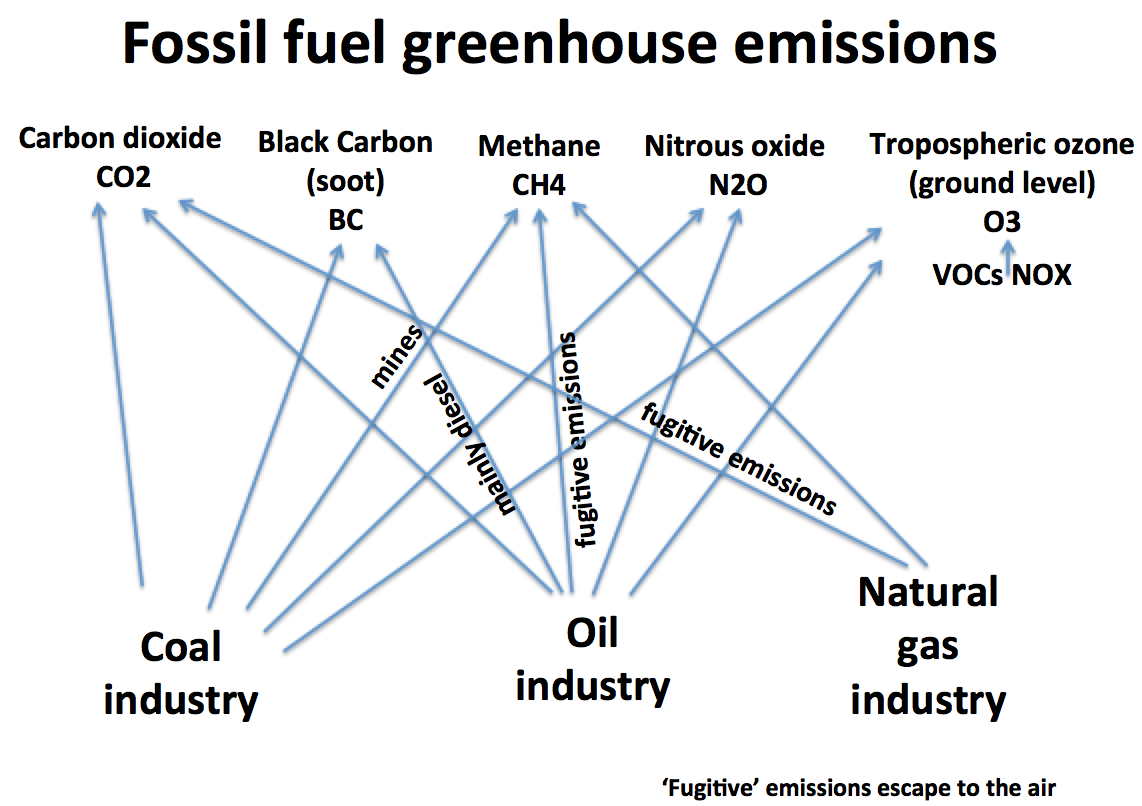
A simple way to look at GHG emissions is from
two big main sources-
1. industrial energy production/use and industrial 2, food production/use
two big main sources-
1. industrial energy production/use and industrial 2, food production/use
Dec 2020 PBL CO2 Global Gas emissions. Global GHG emissions are increasing 1% year.
WORLD ECONOMY TRACKING WORST-CASE SCENARIO
(3 Aug 2020 RCP8.5 tracks cumulative CO2 emissions
(3 Aug 2020 RCP8.5 tracks cumulative CO2 emissions
Jan 2021 Fossil fuels 8 million deaths/year

Fossil fuels emit
CO2: Warming
CH4: Warming methane
N2O (a little) :warming nitrous oxide
BC carbon soot aerosol: warming
SO4 (sulfate) aerosol: cooling
CO2: Warming
CH4: Warming methane
N2O (a little) :warming nitrous oxide
BC carbon soot aerosol: warming
SO4 (sulfate) aerosol: cooling
Chemical industry's top emitter is industrial ammonia (GHG) production for fertilizer
Best regional emissions (2019 Atlas)
Rapid post Covid-19 emissions rebound
(by huge government financing)
(by huge government financing)


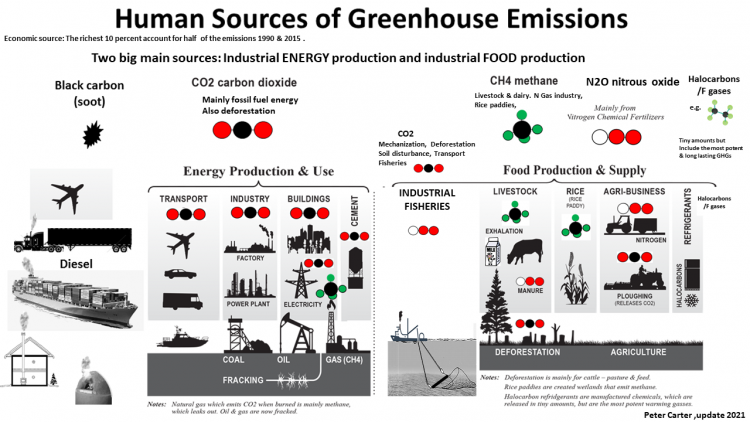
Double click here to edit this text.
Double click here to edit this text.
CO2 is and ultra-long lasting GHG in the atmosphere - about 200 years but 20% lasts 1000 years.
Climate change mitigation therefore requires
elimination of CO2 emissions which means
ZERO CARBON COMBUSTION
No fossil fuels and no wood/biomass
Climate change mitigation therefore requires
elimination of CO2 emissions which means
ZERO CARBON COMBUSTION
No fossil fuels and no wood/biomass
